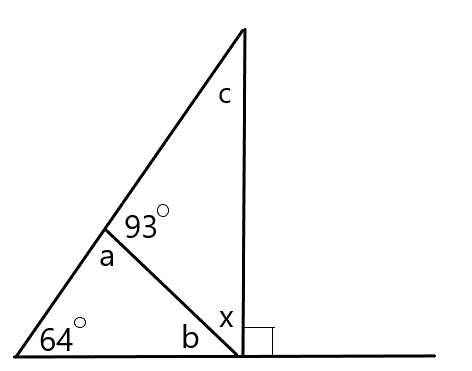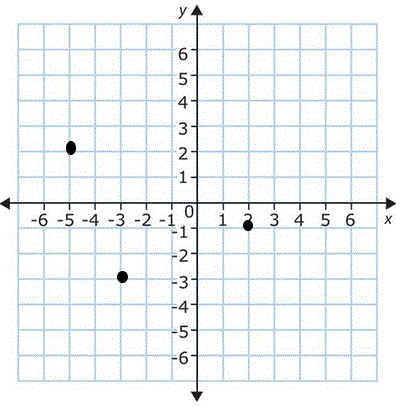
|
Washington State Math Olympiad
Hints and Solutions
2017 Grade 5 Geometry
|
 |
| Problem |
Solution |
1) What is the measure of angle x?
(Figure is not to exact scale)

|
Call the missing angles a (the one that is supplementary with the 93o angle), b (the one next to x) and c (the top one)
Method 1: Use angles a and b
1. Since angle a is supplementary with the 93o angle its value is
180 - 93 = 87 degrees.
2. Angle b is 180 - 64 - 87 = 29 degrees.
3. Angle b, angle x and the right angle add to 180o,
so the value of x = 180 - 90 - 29 = 61 degrees
Method 2: Use angle c
1. Since angle x and angle b sum to 90 degrees, the value of angle c is 180 - 90 - 64 = 26 degrees.
2. Since angle x, angle c and the 93 degree angle sum to 180 degrees, the value of angle x = 180 - 93 - 26 = 61 degrees
|
2) A square has vertices at (2,-1) and (-5,2). Only one of its vertices is in Quadrant III. Give the
coordinates of the vertex that is in Quadrant III.

|
Use the grid to the left to plot the two points.
1. Since only one vertex is in Quadrant III, the two given points cannot be one side of the square or (a) both of the other vertices would be in Quadrant III or (b) neither would be in Quadrant III, so they must be on opposite corners of the square.
2. The new vertex is equidistant from both of these points.
3. Find a point in Quadrant III for whom the sum of its X and Y offsets from point 1 are the same as the sum of its X and Y offsets from point 2 by plotting points on the grid and computing their (X + Y) offsets from both points until you find a point where they add to the same value.
The offsets of point(-3,-3) is (5,2) from the first point and
(2,5) from the second point, which makes that point equidistant from both given points.
The Quadrant III point is (-3,-3)
|
|